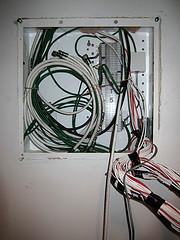Our two pet interests right now seem to be netbooks and video, although there are a lot of other things we find interesting.
Engadget HD asked yesterday whether or not people are still buying DVDs. A poll of people reading a site with HD in the name, indicating the bulk of the readers are likely serious video enthusiasts, more likely to be new technology adopters. However, that said, why are people not buying DVDs in such numbers as they once did?
Some of that is definitely blu-ray. But the price point for blu-ray, especially in this economy, is still not at the level where everything would buy one. A DVD player can be had for dirt cheap. So, yes, people are still buying DVDs. Those economizing are renting them, with Netflix, or even using their computer to watch free or paid content.
Avner Ronen, the CEO of Boxee, commented on Thursday that content companies and cable and IPTV service providers alike are trying to “use their leverage to better survive or avoid change” that is coming to the media industry. “No one likes change except Obama,” he quipped.
Cable programmers receive $22 billion in subscriber fees each year, which makes those providers, and the cable companies who pay the fees to ensure their customers have access to such content, reluctant to change. Recognizing that the web won’t wait for them indefinitely, many cable companies are planning to offer access to online content as part of their subscription-based plans. Private companies like Netflix could even buy those rights as well, allowing them to get into this market.
Mark Cuban responded to Ronen’s comments about how the future of video programming is ala carte with his own thoughts. Mark Cuban is the chairman of HDNet, an all HD programming network, among other things. (Please forgive me for the disjointed nature of the rest of this post, as I try to consolidate a lot of blog comments into a coherent thread)
Why does he, like so many other internet people think content producers are stupid ? Has he, along with so many others pushing internet video not noticed what is happening to the revenues of the content and distribution industries ? Ad Revenues are falling. Quickly. DVD sales are slowing. The per subscriber fees they are getting paid are going up. Not only are they going up, they are consistent.
Now I dont know about you, but for HDNet and my other content companies, we tend to be very nice to those of our customers who pay us every month. Commentary from cable networks and their content producers are saying the same thing. They can’t afford to upset the people who pay the bills.
We agree, the cable company initiative to bring things online for subscribers has a good chance of success because it makes these service contingent on cable subscriptions, and the content providers are very likely to agree to that unless another way to make more money on streaming media is offered. And the cable company keeps increasing rates, perhaps because of falling revenues. But if they don’t get it under control, more and more subscribers will flee.
Cuban goes on the endorse metered Internet, which is a likely alternative manner that cable companies who act as broadband service providers might use to ensure their revenues.
Ronen responded, with a post on the Boxee Blog, maintaining it is not the bundled offering that is going away, but the concept of a channel and the idea that the cable company is the one deciding what content is included in the bundle. As he puts it(we cleaned it up a bit for readability):
As a cable channel your primary concern is your ability to negotiate your way into the basic cable package with as many cable operators, and to get the highest fee for it.
In an Internet/on-demand world your primary concern is the quality of your content, since you are held accountable by the consumer. if consumers want your content they will be willing to pay for it either with cash or with their time (watching ads).
I understand it is a lucrative business. You invest in 1-3 originally produced (or exclusively licensed) core programs, come up with 5-7 cheap to produce shows, license a bunch of syndicated content, get cable companies to carry it and voila! you’ve got a great business. But this model breaks in an on-demand world, and while it may take a few years, the change is inevitable.
Cuban shot back his own reply, pointing out that the Video-On-Demand model works better if the cable company is delivering it with unlimited bandwidth to your device. We tend to agree that the limiting factor on the future of IPTV is bandwidth, but bandwidth to the house continues to increase as user demand encourages infrastructure increase. We have no good way of summarizing his thoughts on why channels will always exist, so we include an excerpt of it here.
The concept of “users always want choice†really really sounds nice. It makes for a great panel argument. But the reality is that its not true. Ultimate choice requires work. Consumers like to think they have choice, but their consumption habits say they prefer easy. Youtube is the perfect example. Millions upon millions of choices that never get seen. The videos that get posted and expected to be seen are the ones from traditional media and providers that already have an audience, ala jon stewart. The rest have to fight for an audience.
TV Guide and guide listings provided onscreen by the cable company allow people to plan what they want to watch, coupled with DVRs to allow them to decided when to watch it. That means people are already migrating to ala carte. Millions of choices may not be seen on TV as well. We know we can’t devote the time to search through 24 hours of programming on the hundreds of channels our cable company bundles in to get the ones we really want.
Having online content as part of a cable subscription is good, but having it as the only option is bad. Competition and variety encourages not only innovation, but keeps prices from being overly inflated. As Avner put it…
I would love for my Cable/Telco providers to focus on being great network providers rather than try to decide what content i should or should not have access to, what application i should or should not run, invent new standards for Interactive TV, Enhanced TV, whatever TV. all with the goal of trying to maintain control, so they don’t lose a grip of their lucrative business model.
Their network infrastructure is a great asset. Their billing relationship with the user is another one. They should try to build their future business around these two foundations.
Innovation in the living room will not come from the set-top makers or the networks. If you would like to see the wild creativity of the Internet come to the TV screen, well you need to let the Internet come to the TV screen..
The arguments and comments seem to go on forever. But what it boils down to is this: no content provider would hurt their profit margins partnering for a subscription-based internet alternative to cable as cable subscribers look for less expensive alternatives. Cable isn’t dead and likely won’t be if they change and grow with the times. People are willing to watch commercials on their computer to get content legally, ala Hulu. US internet infrastructure needs to keep up with the increased bandwidth demand this technology is generating. And finally…things will change. We just have to wait and see how.








![Reblog this post [with Zemanta]](http://img.zemanta.com/reblog_e.png?x-id=93eec8b0-b701-4b22-9011-2beefe7f957d)


![Reblog this post [with Zemanta]](http://img.zemanta.com/reblog_e.png?x-id=e418597f-219d-46b6-9d38-34908b9735b0)